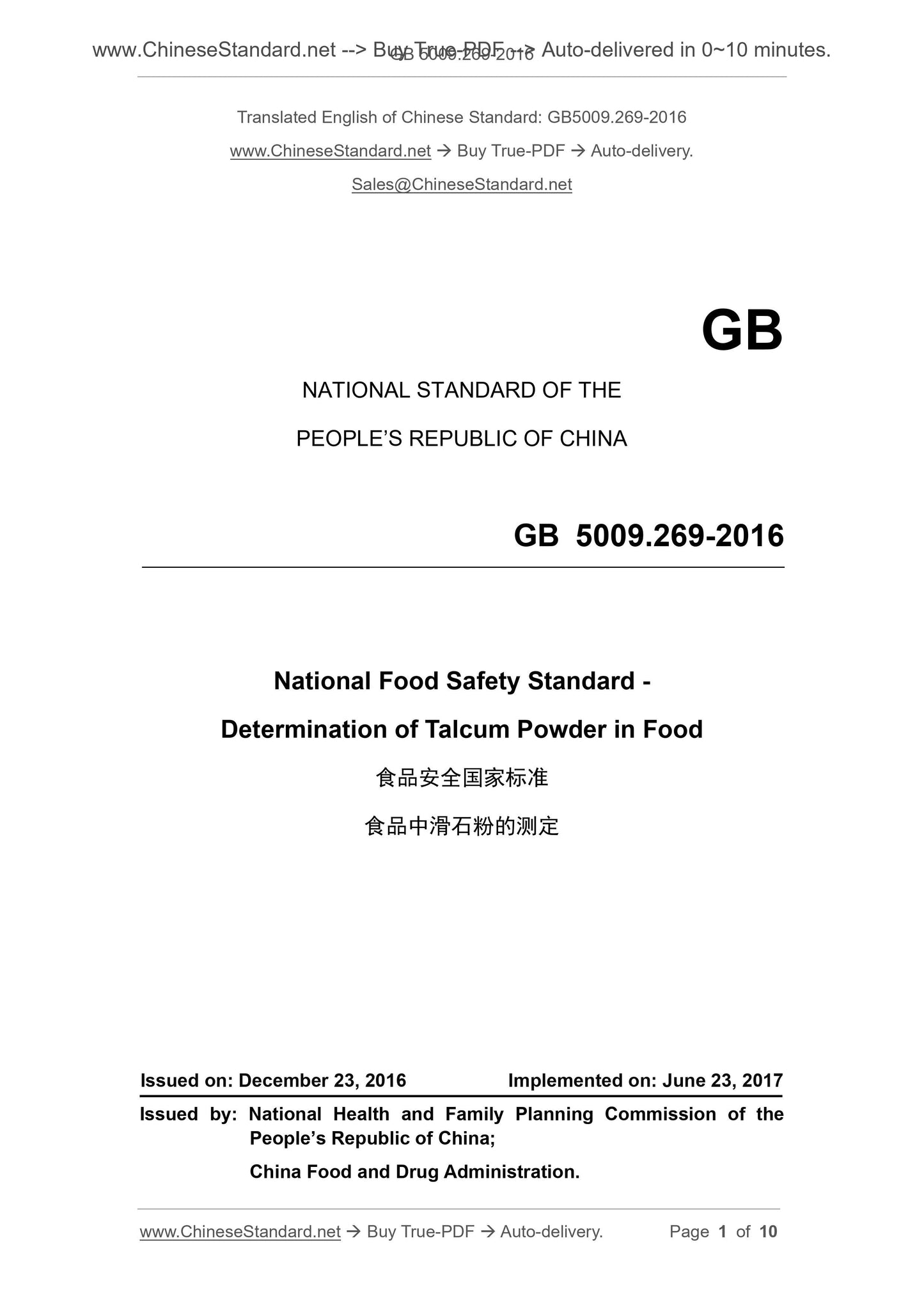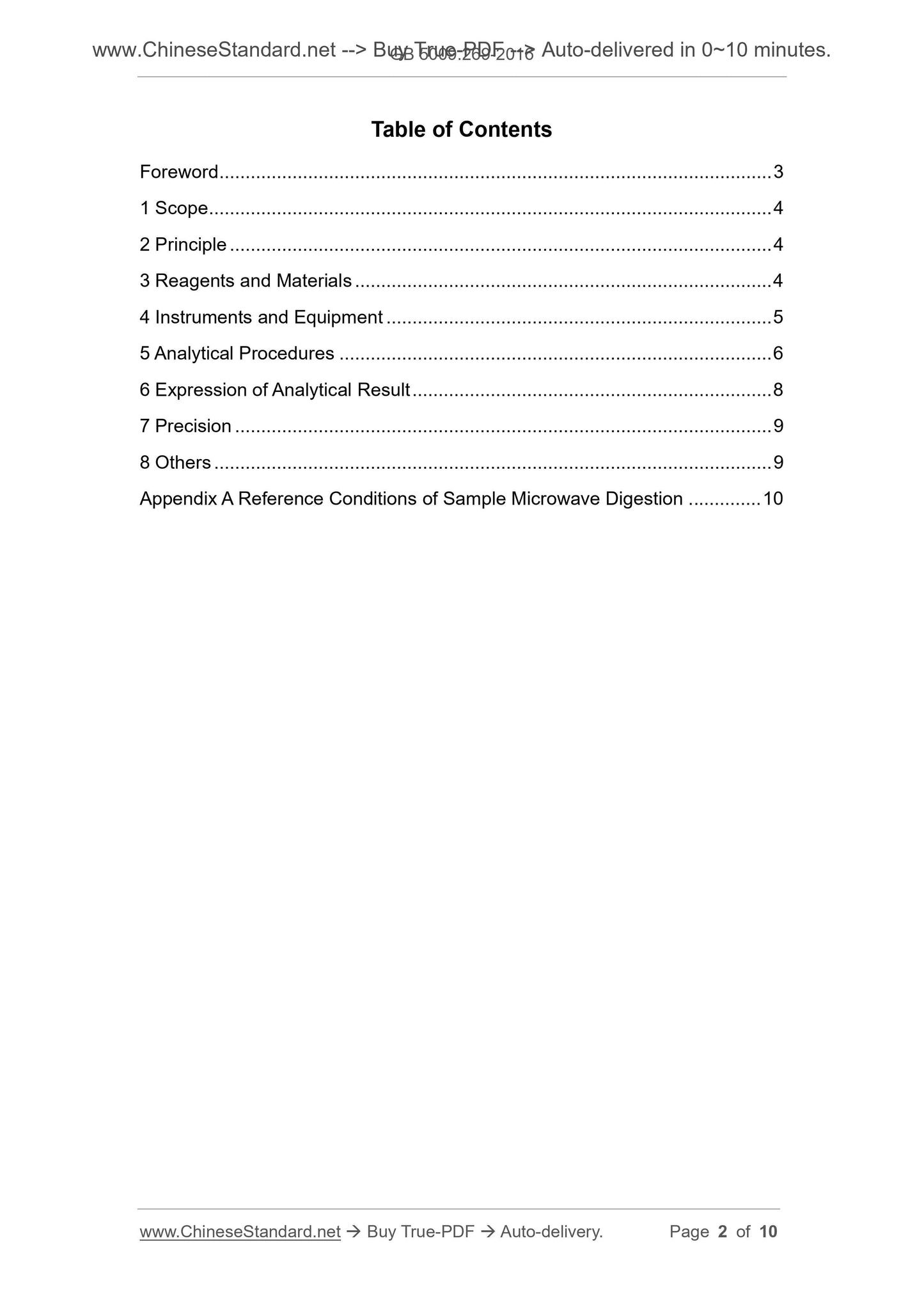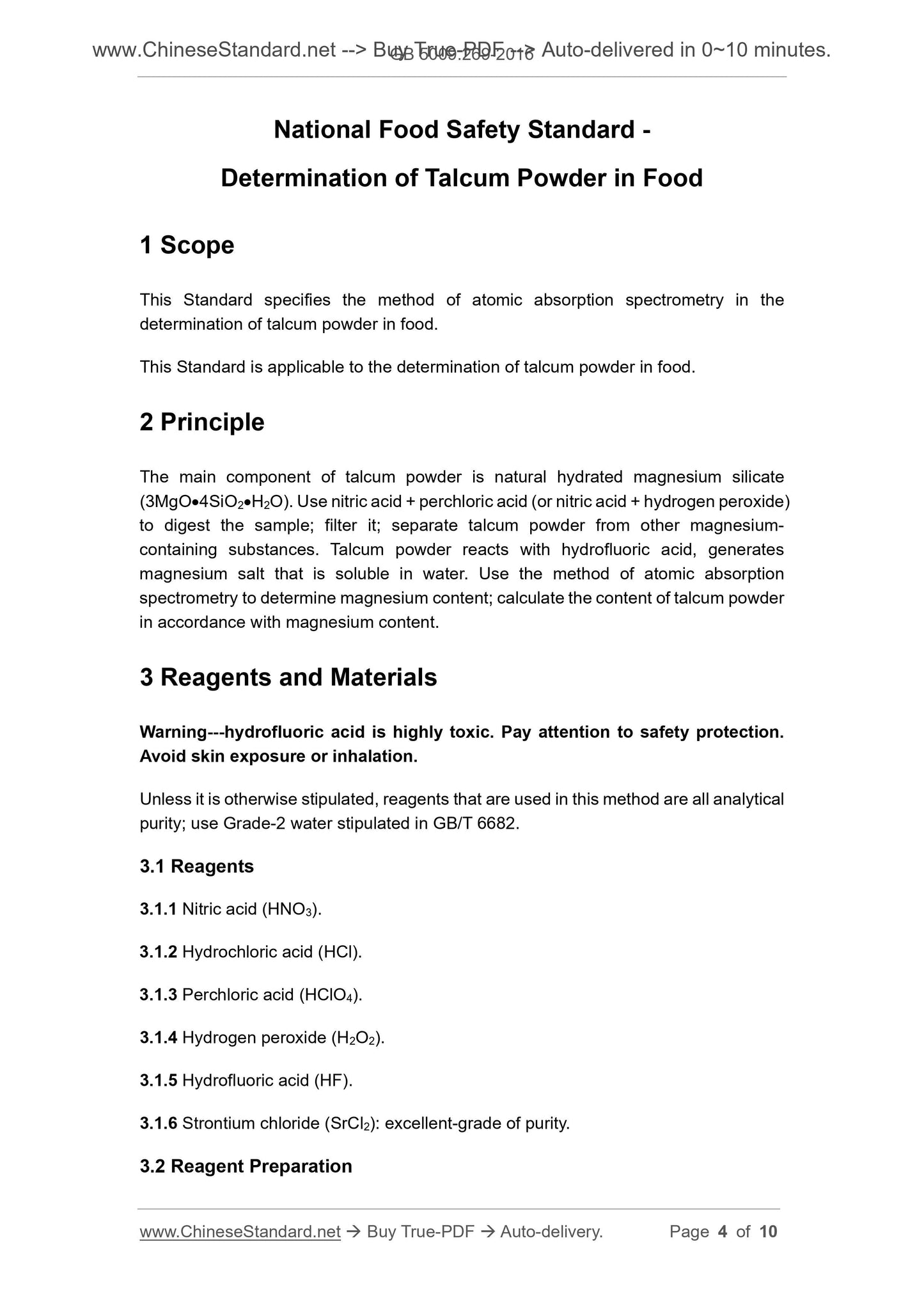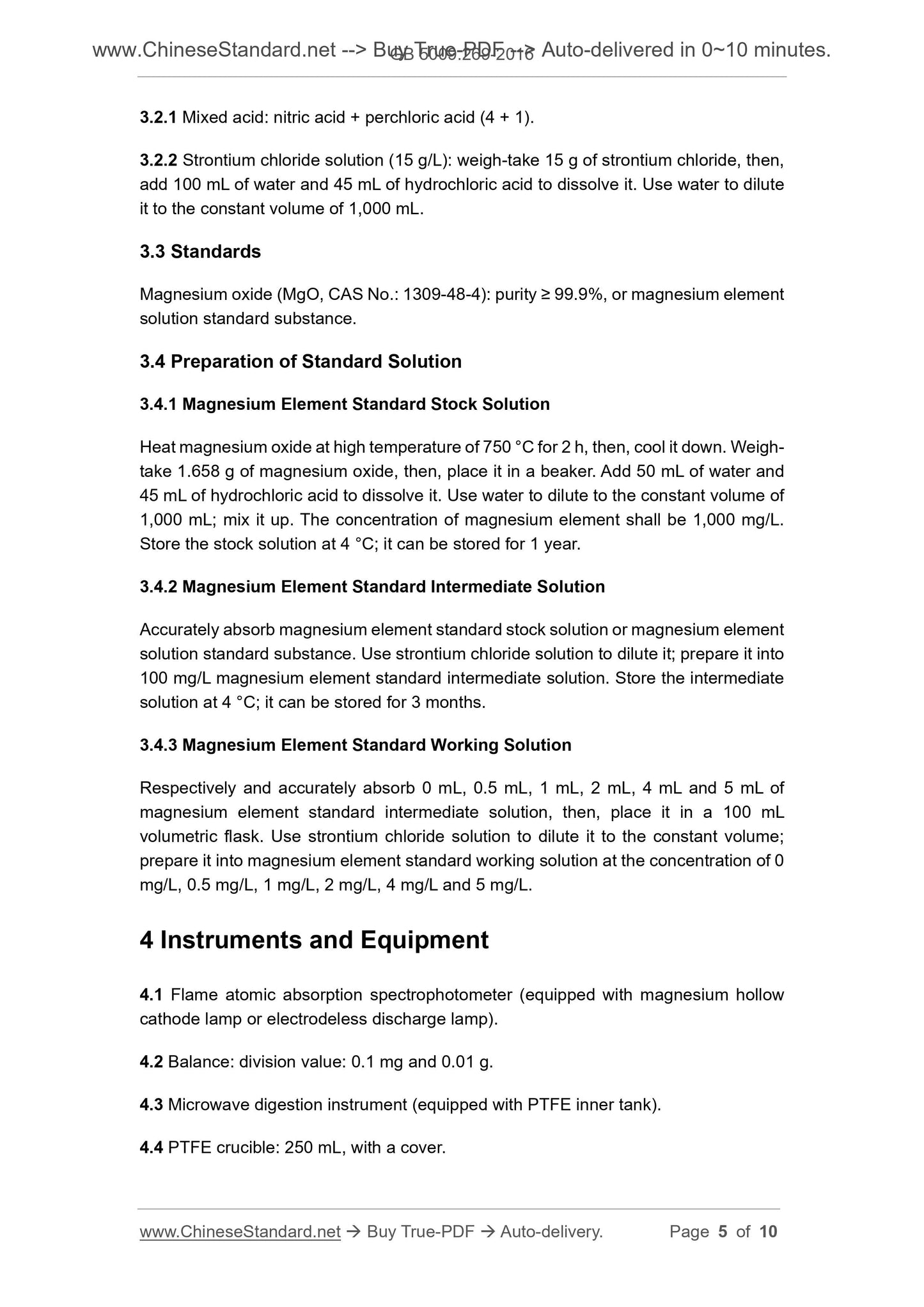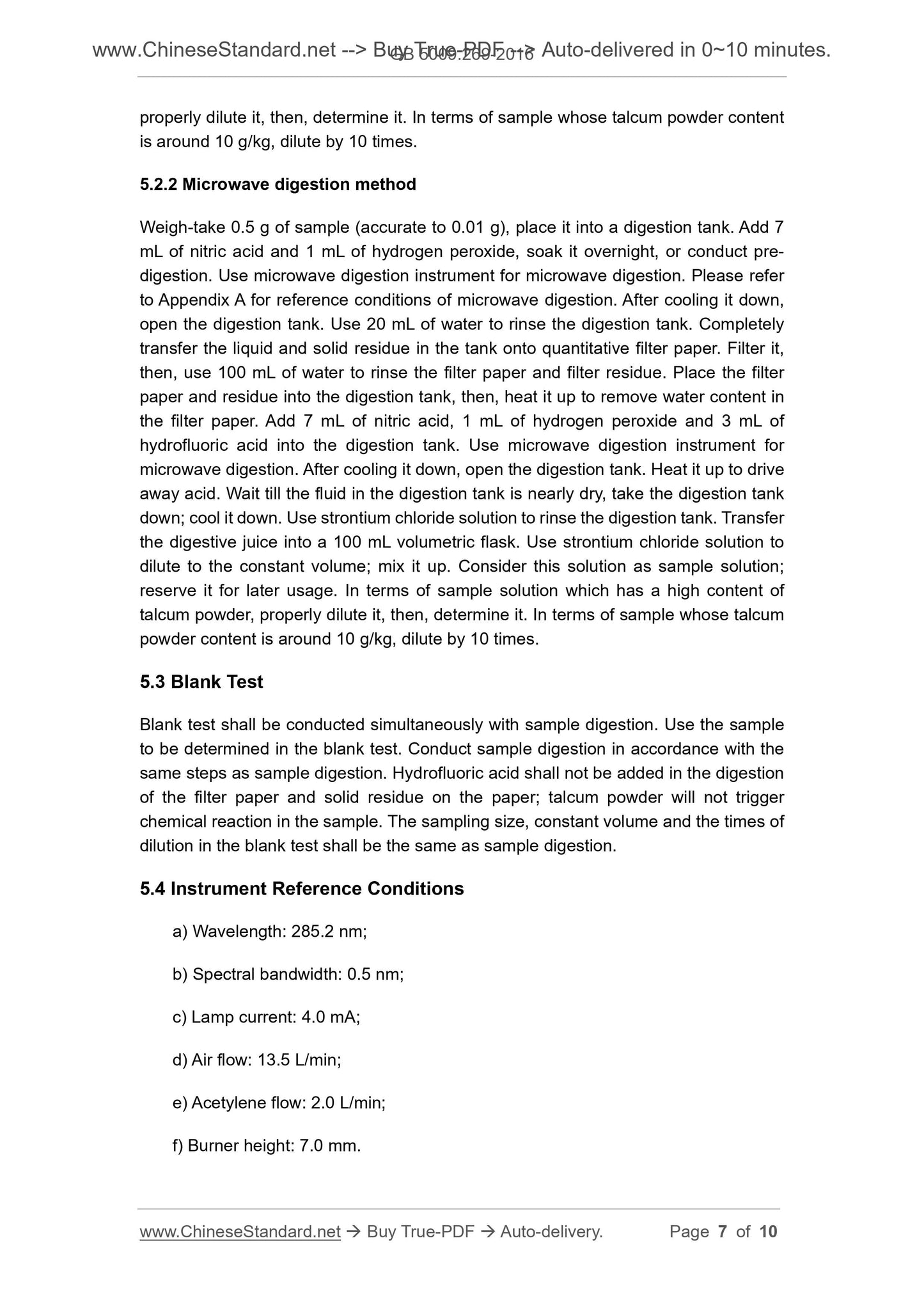1
/
of
5
www.ChineseStandard.us -- Field Test Asia Pte. Ltd.
GB 5009.269-2016 English PDF
GB 5009.269-2016 English PDF
Regular price
$70.00
Regular price
Sale price
$70.00
Unit price
/
per
Shipping calculated at checkout.
Couldn't load pickup availability
GB 5009.269-2016: National food safety standard - Determination of Talcum Powder in Food
Delivery: 9 seconds. Download (& Email) true-PDF + Invoice.
Get Quotation: Click GB 5009.269-2016 (Self-service in 1-minute)
Historical versions (Master-website): GB 5009.269-2016
Preview True-PDF (Reload/Scroll-down if blank)
GB 5009.269-2016
GB
NATIONAL STANDARD OF THE
PEOPLE’S REPUBLIC OF CHINA
National Food Safety Standard -
Determination of Talcum Powder in Food
ISSUED ON. DECEMBER 23, 2016
IMPLEMENTED ON. JUNE 23, 2017
Issued by. National Health and Family Planning Commission of the
People’s Republic of China;
China Food and Drug Administration.
Table of Contents
Foreword ... 3
1 Scope ... 4
2 Principle ... 4
3 Reagents and Materials ... 4
4 Instruments and Equipment ... 5
5 Analytical Procedures ... 6
6 Expression of Analytical Result ... 8
7 Precision ... 9
8 Others ... 9
Appendix A Reference Conditions of Sample Microwave Digestion ... 10
National Food Safety Standard -
Determination of Talcum Powder in Food
1 Scope
This Standard specifies the method of atomic absorption spectrometry in the
determination of talcum powder in food.
This Standard is applicable to the determination of talcum powder in food.
2 Principle
The main component of talcum powder is natural hydrated magnesium silicate
(3MgO4SiO2H2O). Use nitric acid + perchloric acid (or nitric acid + hydrogen peroxide)
to digest the sample; filter it; separate talcum powder from other magnesium-
containing substances. Talcum powder reacts with hydrofluoric acid, generates
magnesium salt that is soluble in water. Use the method of atomic absorption
spectrometry to determine magnesium content; calculate the content of talcum powder
in accordance with magnesium content.
3 Reagents and Materials
Warning---hydrofluoric acid is highly toxic. Pay attention to safety protection.
Avoid skin exposure or inhalation.
Unless it is otherwise stipulated, reagents that are used in this method are all analytical
purity; use Grade-2 water stipulated in GB/T 6682.
3.1 Reagents
3.1.1 Nitric acid (HNO3).
3.1.2 Hydrochloric acid (HCl).
3.1.3 Perchloric acid (HClO4).
3.1.4 Hydrogen peroxide (H2O2).
3.1.5 Hydrofluoric acid (HF).
3.1.6 Strontium chloride (SrCl2). excellent-grade of purity.
3.2 Reagent Preparation
3.2.1 Mixed acid. nitric acid + perchloric acid (4 + 1).
3.2.2 Strontium chloride solution (15 g/L). weigh-take 15 g of strontium chloride, then,
add 100 mL of water and 45 mL of hydrochloric acid to dissolve it. Use water to dilute
it to the constant volume of 1,000 mL.
3.3 Standards
Magnesium oxide (MgO, CAS No.. 1309-48-4). purity ≥ 99.9%, or magnesium element
solution standard substance.
3.4 Preparation of Standard Solution
3.4.1 Magnesium Element Standard Stock Solution
Heat magnesium oxide at high temperature of 750 °C for 2 h, then, cool it down. Weigh-
take 1.658 g of magnesium oxide, then, place it in a beaker. Add 50 mL of water and
45 mL of hydrochloric acid to dissolve it. Use water to dilute to the constant volume of
1,000 mL; mix it up. The concentration of magnesium element shall be 1,000 mg/L.
Store the stock solution at 4 °C; it can be stored for 1 year.
3.4.2 Magnesium Element Standard Intermediate Solution
Accurately absorb magnesium element standard stock solution or magnesium element
solution standard substance. Use strontium chloride solution to dilute it; prepare it into
100 mg/L magnesium element standard intermediate solution. Store the intermediate
solution at 4 °C; it can be stored for 3 months.
3.4.3 Magnesium Element Standard Working Solution
Respectively and accurately absorb 0 mL, 0.5 mL, 1 mL, 2 mL, 4 mL and 5 mL of
magnesium element standard intermediate solution, then, place it in a 100 mL
volumetric flask. Use strontium chloride solution to dilute it to the constant volume;
prepare it into magnesium element standard working solution at the concentration of 0
mg/L, 0.5 mg/L, 1 mg/L, 2 mg/L, 4 mg/L and 5 mg/L.
4 Instruments and Equipment
4.1 Flame atomic absorption spectrophotometer (equipped with magnesium hollow
cathode lamp or electrodeless discharge lamp).
4.2 Balance. division value. 0.1 mg and 0.01 g.
4.3 Microwave digestion instrument (equipped with PTFE inner tank).
4.4 PTFE crucible. 250 mL, with a cover.
properly dilute it, then, determine it. In terms of sample whose talcum powder content
is around 10 g/kg, dilute by 10 times.
5.2.2 Microwave digestion method
Weigh-take 0.5 g of sample (accurate to 0.01 g), place it into a digestion tank. Add 7
mL of nitric acid and 1 mL of hydrogen peroxide, soak it overnight, or conduct pre-
digestion. Use microwave digestion instrument for microwave digestion. Please refer
to Appendix A for reference conditions of microwave digestion. After cooling it down,
open the digestion tank. Use 20 mL of water to rinse the digestion tank. Completely
transfer the liquid and solid residue in the tank onto quantitative filter paper. Filter it,
then, use 100 mL of water to rinse the filter paper and filter residue. Place the filter
paper and residue into the digestion tank, then, heat it up to remove water content in
the filter paper. Add 7 mL of nitric acid, 1 mL of hydrogen peroxide and 3 mL of
hydrofluoric acid into the digestion tank. Use microwave digestion instrument for
microwave digestion. After cooling it down, open the digestion tank. Heat it up to drive
away acid. Wait till the fluid in the digestion tank is nearly dry, take the digestion tank
down; cool it down. Use strontium chloride solution to rinse the digestion tank. Transfer
the digestive juice into a 100 mL volumetric flask. Use strontium chloride solution to
dilute to the constant volume; mix it up. Consider this solution as sample solution;
reserve it for later usage. In terms of sample solution which has a high content of
talcum powder, properly dilute it, then, determine it. In terms of sample whose talcum
powder content is around 10 g/kg, dilute by 10 times.
5.3 Blank Test
Blank test shall be conducted simultaneously with sample digestion. Use the sample
to be determined in the blank test. Conduct sample digestion in accordance with the
same steps as sample digestion. Hydrofluoric acid shall not be added in the digestion
of the filter paper and solid residue on the paper; talcum powder will not trigger
chemical reaction in the sample. The sampling size, constant volume and the times of
dilution in the blank test shall be the same as sample digestion.
5.4 Instrument Reference Conditions
a) Wavelength. 285.2 nm;
b) Spectral bandwidth. 0.5 nm;
c) Lamp current. 4.0 mA;
d) Air flow. 13.5 L/min;
e) Acetylene flow. 2.0 L/min;
f) Burner height. 7.0 mm.
GB 5009.269-2016
GB
NATIONAL STANDARD OF THE
PEOPLE’S REPUBLIC OF CHINA
National Food Safety Standard -
Determination of Talcum Powder in Food
ISSUED ON. DECEMBER 23, 2016
IMPLEMENTED ON. JUNE 23, 2017
Issued by. National Health and Family Planning Commission of the
People’s Republic of China;
China Food and Drug Administration.
Table of Contents
Foreword ... 3
1 Scope ... 4
2 Principle ... 4
3 Reagents and Materials ... 4
4 Instruments and Equipment ... 5
5 Analytical Procedures ... 6
6 Expression of Analytical Result ... 8
7 Precision ... 9
8 Others ... 9
Appendix A Reference Conditions of Sample Microwave Digestion ... 10
National Food Safety Standard -
Determination of Talcum Powder in Food
1 Scope
This Standard specifies the method of atomic absorption spectrometry in the
determination of talcum powder in food.
This Standard is applicable to the determination of talcum powder in food.
2 Principle
The main component of talcum powder is natural hydrated magnesium silicate
(3MgO4SiO2H2O). Use nitric acid + perchloric acid (or nitric acid + hydrogen peroxide)
to digest the sample; filter it; separate talcum powder from other magnesium-
containing substances. Talcum powder reacts with hydrofluoric acid, generates
magnesium salt that is soluble in water. Use the method of atomic absorption
spectrometry to determine magnesium content; calculate the content of talcum powder
in accordance with magnesium content.
3 Reagents and Materials
Warning---hydrofluoric acid is highly toxic. Pay attention to safety protection.
Avoid skin exposure or inhalation.
Unless it is otherwise stipulated, reagents that are used in this method are all analytical
purity; use Grade-2 water stipulated in GB/T 6682.
3.1 Reagents
3.1.1 Nitric acid (HNO3).
3.1.2 Hydrochloric acid (HCl).
3.1.3 Perchloric acid (HClO4).
3.1.4 Hydrogen peroxide (H2O2).
3.1.5 Hydrofluoric acid (HF).
3.1.6 Strontium chloride (SrCl2). excellent-grade of purity.
3.2 Reagent Preparation
3.2.1 Mixed acid. nitric acid + perchloric acid (4 + 1).
3.2.2 Strontium chloride solution (15 g/L). weigh-take 15 g of strontium chloride, then,
add 100 mL of water and 45 mL of hydrochloric acid to dissolve it. Use water to dilute
it to the constant volume of 1,000 mL.
3.3 Standards
Magnesium oxide (MgO, CAS No.. 1309-48-4). purity ≥ 99.9%, or magnesium element
solution standard substance.
3.4 Preparation of Standard Solution
3.4.1 Magnesium Element Standard Stock Solution
Heat magnesium oxide at high temperature of 750 °C for 2 h, then, cool it down. Weigh-
take 1.658 g of magnesium oxide, then, place it in a beaker. Add 50 mL of water and
45 mL of hydrochloric acid to dissolve it. Use water to dilute to the constant volume of
1,000 mL; mix it up. The concentration of magnesium element shall be 1,000 mg/L.
Store the stock solution at 4 °C; it can be stored for 1 year.
3.4.2 Magnesium Element Standard Intermediate Solution
Accurately absorb magnesium element standard stock solution or magnesium element
solution standard substance. Use strontium chloride solution to dilute it; prepare it into
100 mg/L magnesium element standard intermediate solution. Store the intermediate
solution at 4 °C; it can be stored for 3 months.
3.4.3 Magnesium Element Standard Working Solution
Respectively and accurately absorb 0 mL, 0.5 mL, 1 mL, 2 mL, 4 mL and 5 mL of
magnesium element standard intermediate solution, then, place it in a 100 mL
volumetric flask. Use strontium chloride solution to dilute it to the constant volume;
prepare it into magnesium element standard working solution at the concentration of 0
mg/L, 0.5 mg/L, 1 mg/L, 2 mg/L, 4 mg/L and 5 mg/L.
4 Instruments and Equipment
4.1 Flame atomic absorption spectrophotometer (equipped with magnesium hollow
cathode lamp or electrodeless discharge lamp).
4.2 Balance. division value. 0.1 mg and 0.01 g.
4.3 Microwave digestion instrument (equipped with PTFE inner tank).
4.4 PTFE crucible. 250 mL, with a cover.
properly dilute it, then, determine it. In terms of sample whose talcum powder content
is around 10 g/kg, dilute by 10 times.
5.2.2 Microwave digestion method
Weigh-take 0.5 g of sample (accurate to 0.01 g), place it into a digestion tank. Add 7
mL of nitric acid and 1 mL of hydrogen peroxide, soak it overnight, or conduct pre-
digestion. Use microwave digestion instrument for microwave digestion. Please refer
to Appendix A for reference conditions of microwave digestion. After cooling it down,
open the digestion tank. Use 20 mL of water to rinse the digestion tank. Completely
transfer the liquid and solid residue in the tank onto quantitative filter paper. Filter it,
then, use 100 mL of water to rinse the filter paper and filter residue. Place the filter
paper and residue into the digestion tank, then, heat it up to remove water content in
the filter paper. Add 7 mL of nitric acid, 1 mL of hydrogen peroxide and 3 mL of
hydrofluoric acid into the digestion tank. Use microwave digestion instrument for
microwave digestion. After cooling it down, open the digestion tank. Heat it up to drive
away acid. Wait till the fluid in the digestion tank is nearly dry, take the digestion tank
down; cool it down. Use strontium chloride solution to rinse the digestion tank. Transfer
the digestive juice into a 100 mL volumetric flask. Use strontium chloride solution to
dilute to the constant volume; mix it up. Consider this solution as sample solution;
reserve it for later usage. In terms of sample solution which has a high content of
talcum powder, properly dilute it, then, determine it. In terms of sample whose talcum
powder content is around 10 g/kg, dilute by 10 times.
5.3 Blank Test
Blank test shall be conducted simultaneously with sample digestion. Use the sample
to be determined in the blank test. Conduct sample digestion in accordance with the
same steps as sample digestion. Hydrofluoric acid shall not be added in the digestion
of the filter paper and solid residue on the paper; talcum powder will not trigger
chemical reaction in the sample. The sampling size, constant volume and the times of
dilution in the blank test shall be the same as sample digestion.
5.4 Instrument Reference Conditions
a) Wavelength. 285.2 nm;
b) Spectral bandwidth. 0.5 nm;
c) Lamp current. 4.0 mA;
d) Air flow. 13.5 L/min;
e) Acetylene flow. 2.0 L/min;
f) Burner height. 7.0 mm.
Delivery: 9 seconds. Download (& Email) true-PDF + Invoice.
Get Quotation: Click GB 5009.269-2016 (Self-service in 1-minute)
Historical versions (Master-website): GB 5009.269-2016
Preview True-PDF (Reload/Scroll-down if blank)
GB 5009.269-2016
GB
NATIONAL STANDARD OF THE
PEOPLE’S REPUBLIC OF CHINA
National Food Safety Standard -
Determination of Talcum Powder in Food
ISSUED ON. DECEMBER 23, 2016
IMPLEMENTED ON. JUNE 23, 2017
Issued by. National Health and Family Planning Commission of the
People’s Republic of China;
China Food and Drug Administration.
Table of Contents
Foreword ... 3
1 Scope ... 4
2 Principle ... 4
3 Reagents and Materials ... 4
4 Instruments and Equipment ... 5
5 Analytical Procedures ... 6
6 Expression of Analytical Result ... 8
7 Precision ... 9
8 Others ... 9
Appendix A Reference Conditions of Sample Microwave Digestion ... 10
National Food Safety Standard -
Determination of Talcum Powder in Food
1 Scope
This Standard specifies the method of atomic absorption spectrometry in the
determination of talcum powder in food.
This Standard is applicable to the determination of talcum powder in food.
2 Principle
The main component of talcum powder is natural hydrated magnesium silicate
(3MgO4SiO2H2O). Use nitric acid + perchloric acid (or nitric acid + hydrogen peroxide)
to digest the sample; filter it; separate talcum powder from other magnesium-
containing substances. Talcum powder reacts with hydrofluoric acid, generates
magnesium salt that is soluble in water. Use the method of atomic absorption
spectrometry to determine magnesium content; calculate the content of talcum powder
in accordance with magnesium content.
3 Reagents and Materials
Warning---hydrofluoric acid is highly toxic. Pay attention to safety protection.
Avoid skin exposure or inhalation.
Unless it is otherwise stipulated, reagents that are used in this method are all analytical
purity; use Grade-2 water stipulated in GB/T 6682.
3.1 Reagents
3.1.1 Nitric acid (HNO3).
3.1.2 Hydrochloric acid (HCl).
3.1.3 Perchloric acid (HClO4).
3.1.4 Hydrogen peroxide (H2O2).
3.1.5 Hydrofluoric acid (HF).
3.1.6 Strontium chloride (SrCl2). excellent-grade of purity.
3.2 Reagent Preparation
3.2.1 Mixed acid. nitric acid + perchloric acid (4 + 1).
3.2.2 Strontium chloride solution (15 g/L). weigh-take 15 g of strontium chloride, then,
add 100 mL of water and 45 mL of hydrochloric acid to dissolve it. Use water to dilute
it to the constant volume of 1,000 mL.
3.3 Standards
Magnesium oxide (MgO, CAS No.. 1309-48-4). purity ≥ 99.9%, or magnesium element
solution standard substance.
3.4 Preparation of Standard Solution
3.4.1 Magnesium Element Standard Stock Solution
Heat magnesium oxide at high temperature of 750 °C for 2 h, then, cool it down. Weigh-
take 1.658 g of magnesium oxide, then, place it in a beaker. Add 50 mL of water and
45 mL of hydrochloric acid to dissolve it. Use water to dilute to the constant volume of
1,000 mL; mix it up. The concentration of magnesium element shall be 1,000 mg/L.
Store the stock solution at 4 °C; it can be stored for 1 year.
3.4.2 Magnesium Element Standard Intermediate Solution
Accurately absorb magnesium element standard stock solution or magnesium element
solution standard substance. Use strontium chloride solution to dilute it; prepare it into
100 mg/L magnesium element standard intermediate solution. Store the intermediate
solution at 4 °C; it can be stored for 3 months.
3.4.3 Magnesium Element Standard Working Solution
Respectively and accurately absorb 0 mL, 0.5 mL, 1 mL, 2 mL, 4 mL and 5 mL of
magnesium element standard intermediate solution, then, place it in a 100 mL
volumetric flask. Use strontium chloride solution to dilute it to the constant volume;
prepare it into magnesium element standard working solution at the concentration of 0
mg/L, 0.5 mg/L, 1 mg/L, 2 mg/L, 4 mg/L and 5 mg/L.
4 Instruments and Equipment
4.1 Flame atomic absorption spectrophotometer (equipped with magnesium hollow
cathode lamp or electrodeless discharge lamp).
4.2 Balance. division value. 0.1 mg and 0.01 g.
4.3 Microwave digestion instrument (equipped with PTFE inner tank).
4.4 PTFE crucible. 250 mL, with a cover.
properly dilute it, then, determine it. In terms of sample whose talcum powder content
is around 10 g/kg, dilute by 10 times.
5.2.2 Microwave digestion method
Weigh-take 0.5 g of sample (accurate to 0.01 g), place it into a digestion tank. Add 7
mL of nitric acid and 1 mL of hydrogen peroxide, soak it overnight, or conduct pre-
digestion. Use microwave digestion instrument for microwave digestion. Please refer
to Appendix A for reference conditions of microwave digestion. After cooling it down,
open the digestion tank. Use 20 mL of water to rinse the digestion tank. Completely
transfer the liquid and solid residue in the tank onto quantitative filter paper. Filter it,
then, use 100 mL of water to rinse the filter paper and filter residue. Place the filter
paper and residue into the digestion tank, then, heat it up to remove water content in
the filter paper. Add 7 mL of nitric acid, 1 mL of hydrogen peroxide and 3 mL of
hydrofluoric acid into the digestion tank. Use microwave digestion instrument for
microwave digestion. After cooling it down, open the digestion tank. Heat it up to drive
away acid. Wait till the fluid in the digestion tank is nearly dry, take the digestion tank
down; cool it down. Use strontium chloride solution to rinse the digestion tank. Transfer
the digestive juice into a 100 mL volumetric flask. Use strontium chloride solution to
dilute to the constant volume; mix it up. Consider this solution as sample solution;
reserve it for later usage. In terms of sample solution which has a high content of
talcum powder, properly dilute it, then, determine it. In terms of sample whose talcum
powder content is around 10 g/kg, dilute by 10 times.
5.3 Blank Test
Blank test shall be conducted simultaneously with sample digestion. Use the sample
to be determined in the blank test. Conduct sample digestion in accordance with the
same steps as sample digestion. Hydrofluoric acid shall not be added in the digestion
of the filter paper and solid residue on the paper; talcum powder will not trigger
chemical reaction in the sample. The sampling size, constant volume and the times of
dilution in the blank test shall be the same as sample digestion.
5.4 Instrument Reference Conditions
a) Wavelength. 285.2 nm;
b) Spectral bandwidth. 0.5 nm;
c) Lamp current. 4.0 mA;
d) Air flow. 13.5 L/min;
e) Acetylene flow. 2.0 L/min;
f) Burner height. 7.0 mm.
GB 5009.269-2016
GB
NATIONAL STANDARD OF THE
PEOPLE’S REPUBLIC OF CHINA
National Food Safety Standard -
Determination of Talcum Powder in Food
ISSUED ON. DECEMBER 23, 2016
IMPLEMENTED ON. JUNE 23, 2017
Issued by. National Health and Family Planning Commission of the
People’s Republic of China;
China Food and Drug Administration.
Table of Contents
Foreword ... 3
1 Scope ... 4
2 Principle ... 4
3 Reagents and Materials ... 4
4 Instruments and Equipment ... 5
5 Analytical Procedures ... 6
6 Expression of Analytical Result ... 8
7 Precision ... 9
8 Others ... 9
Appendix A Reference Conditions of Sample Microwave Digestion ... 10
National Food Safety Standard -
Determination of Talcum Powder in Food
1 Scope
This Standard specifies the method of atomic absorption spectrometry in the
determination of talcum powder in food.
This Standard is applicable to the determination of talcum powder in food.
2 Principle
The main component of talcum powder is natural hydrated magnesium silicate
(3MgO4SiO2H2O). Use nitric acid + perchloric acid (or nitric acid + hydrogen peroxide)
to digest the sample; filter it; separate talcum powder from other magnesium-
containing substances. Talcum powder reacts with hydrofluoric acid, generates
magnesium salt that is soluble in water. Use the method of atomic absorption
spectrometry to determine magnesium content; calculate the content of talcum powder
in accordance with magnesium content.
3 Reagents and Materials
Warning---hydrofluoric acid is highly toxic. Pay attention to safety protection.
Avoid skin exposure or inhalation.
Unless it is otherwise stipulated, reagents that are used in this method are all analytical
purity; use Grade-2 water stipulated in GB/T 6682.
3.1 Reagents
3.1.1 Nitric acid (HNO3).
3.1.2 Hydrochloric acid (HCl).
3.1.3 Perchloric acid (HClO4).
3.1.4 Hydrogen peroxide (H2O2).
3.1.5 Hydrofluoric acid (HF).
3.1.6 Strontium chloride (SrCl2). excellent-grade of purity.
3.2 Reagent Preparation
3.2.1 Mixed acid. nitric acid + perchloric acid (4 + 1).
3.2.2 Strontium chloride solution (15 g/L). weigh-take 15 g of strontium chloride, then,
add 100 mL of water and 45 mL of hydrochloric acid to dissolve it. Use water to dilute
it to the constant volume of 1,000 mL.
3.3 Standards
Magnesium oxide (MgO, CAS No.. 1309-48-4). purity ≥ 99.9%, or magnesium element
solution standard substance.
3.4 Preparation of Standard Solution
3.4.1 Magnesium Element Standard Stock Solution
Heat magnesium oxide at high temperature of 750 °C for 2 h, then, cool it down. Weigh-
take 1.658 g of magnesium oxide, then, place it in a beaker. Add 50 mL of water and
45 mL of hydrochloric acid to dissolve it. Use water to dilute to the constant volume of
1,000 mL; mix it up. The concentration of magnesium element shall be 1,000 mg/L.
Store the stock solution at 4 °C; it can be stored for 1 year.
3.4.2 Magnesium Element Standard Intermediate Solution
Accurately absorb magnesium element standard stock solution or magnesium element
solution standard substance. Use strontium chloride solution to dilute it; prepare it into
100 mg/L magnesium element standard intermediate solution. Store the intermediate
solution at 4 °C; it can be stored for 3 months.
3.4.3 Magnesium Element Standard Working Solution
Respectively and accurately absorb 0 mL, 0.5 mL, 1 mL, 2 mL, 4 mL and 5 mL of
magnesium element standard intermediate solution, then, place it in a 100 mL
volumetric flask. Use strontium chloride solution to dilute it to the constant volume;
prepare it into magnesium element standard working solution at the concentration of 0
mg/L, 0.5 mg/L, 1 mg/L, 2 mg/L, 4 mg/L and 5 mg/L.
4 Instruments and Equipment
4.1 Flame atomic absorption spectrophotometer (equipped with magnesium hollow
cathode lamp or electrodeless discharge lamp).
4.2 Balance. division value. 0.1 mg and 0.01 g.
4.3 Microwave digestion instrument (equipped with PTFE inner tank).
4.4 PTFE crucible. 250 mL, with a cover.
properly dilute it, then, determine it. In terms of sample whose talcum powder content
is around 10 g/kg, dilute by 10 times.
5.2.2 Microwave digestion method
Weigh-take 0.5 g of sample (accurate to 0.01 g), place it into a digestion tank. Add 7
mL of nitric acid and 1 mL of hydrogen peroxide, soak it overnight, or conduct pre-
digestion. Use microwave digestion instrument for microwave digestion. Please refer
to Appendix A for reference conditions of microwave digestion. After cooling it down,
open the digestion tank. Use 20 mL of water to rinse the digestion tank. Completely
transfer the liquid and solid residue in the tank onto quantitative filter paper. Filter it,
then, use 100 mL of water to rinse the filter paper and filter residue. Place the filter
paper and residue into the digestion tank, then, heat it up to remove water content in
the filter paper. Add 7 mL of nitric acid, 1 mL of hydrogen peroxide and 3 mL of
hydrofluoric acid into the digestion tank. Use microwave digestion instrument for
microwave digestion. After cooling it down, open the digestion tank. Heat it up to drive
away acid. Wait till the fluid in the digestion tank is nearly dry, take the digestion tank
down; cool it down. Use strontium chloride solution to rinse the digestion tank. Transfer
the digestive juice into a 100 mL volumetric flask. Use strontium chloride solution to
dilute to the constant volume; mix it up. Consider this solution as sample solution;
reserve it for later usage. In terms of sample solution which has a high content of
talcum powder, properly dilute it, then, determine it. In terms of sample whose talcum
powder content is around 10 g/kg, dilute by 10 times.
5.3 Blank Test
Blank test shall be conducted simultaneously with sample digestion. Use the sample
to be determined in the blank test. Conduct sample digestion in accordance with the
same steps as sample digestion. Hydrofluoric acid shall not be added in the digestion
of the filter paper and solid residue on the paper; talcum powder will not trigger
chemical reaction in the sample. The sampling size, constant volume and the times of
dilution in the blank test shall be the same as sample digestion.
5.4 Instrument Reference Conditions
a) Wavelength. 285.2 nm;
b) Spectral bandwidth. 0.5 nm;
c) Lamp current. 4.0 mA;
d) Air flow. 13.5 L/min;
e) Acetylene flow. 2.0 L/min;
f) Burner height. 7.0 mm.
Share
